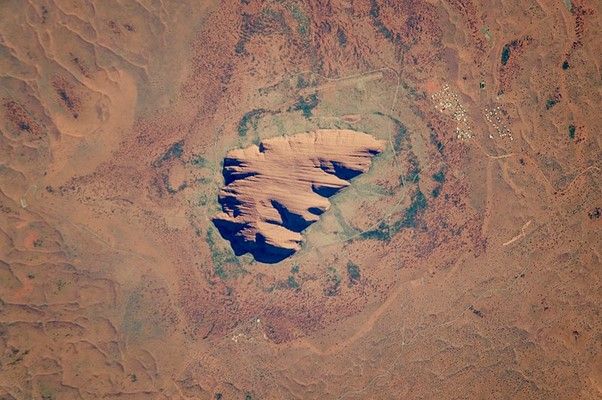Home/Curriculum resources/Communicating traditional Indigenous Knowledge/Ngadju representations of fire (Great Western Woodlands, Western Australia)
Learning Area:
English
Year level:
Level 6

Ngadju representations of fire (Great Western Woodlands, Western Australia)
This case study is a part of the Communicating traditional Indigenous Knowledge resource.
Uluru from Above. Photographer: NASA/JSC Gateway to Astronaut Photography of Earth. Source: Wikimedia Commons. License: CC BY 2.0
The Ngadju (also referred to as Marlpa) people are from the south-eastern goldfields region in Western Australia. Ngadju kala: Ngadju fire knowledge and contemporary fire management in the Great Western Woodlands (2013) is a document produced by the Ngadju Nation and CSIRO 0 , and records Ngadju knowledge about fire.
Communicating cultural fire knowledge and practices in a document involved using culturally appropriate methods to collate and share aspects of that knowledge. For example, the Ngadju kala document includes a story and song about how fire was given to the Ngadju people 0 . This story was told by Marlpa man Jimmer of Drollinya, and recorded by Daisy Bates around the year 1908 0 . The use of the name, language group and location of the person who told the story is significant and reflects the way that traditional knowledge is embedded in country and language and cultural groups.
In addition to stories recorded in the past, the document features recent quotes by Ngadju people. These quotations are unedited, and reflect the diversity of languages, including Aboriginal English, to convey specific knowledge. For example: “Fire connects Indigenous people around the world. Fire is culture: water is number one; fire is second only to water.” Stephen Rule, Norseman’ 0 “Ngadju country is unique. Up north is different to here. Central Australia is different to here. The more you burn that country, the better things grow. The jarrah and black boys [Xanthorrhoea australis] in the south-west—they won’t grow without fire. But here — if you burn the gimlets (joorderee) or salmon gums (marrlinja) it takes hundreds or thousands of years to come back. So Ngadju didn’t burn much in the old growth woodlands. Some areas need to be burnt a lot, but not everything does. Ngadju just burn in specific places. Les Schultz, Coolgardie” 0 These contemporary quotations record where the speaker is from, reflecting continuity of their link to this country.
In this document, images, maps and diagrams are used in new ways to communicate Ngadju fire knowledge. The diagram ‘Journey to a Ngadju fire gathering’ provides a visual depiction of a temporal sequence explaining how fire was used by different members of a travelling party, as they followed a Song Series (or Songline) through the landscape 0 . The Ngadju seasonal calendar provides a graphical representation of Ngadju seasonal knowledge 0 . This calendar uses Ngadju words and English translation to show when significant seasonal events occur in the landscape, such as animals hatching in Ngawa, the egging season, which occurs around September and October.
All of these methods for communicating Ngadju knowledge are forms of cultural narratives or story-telling and reflect the various ways Aboriginal and Torres Strait Islander Peoples communicate traditional knowledge 0 .